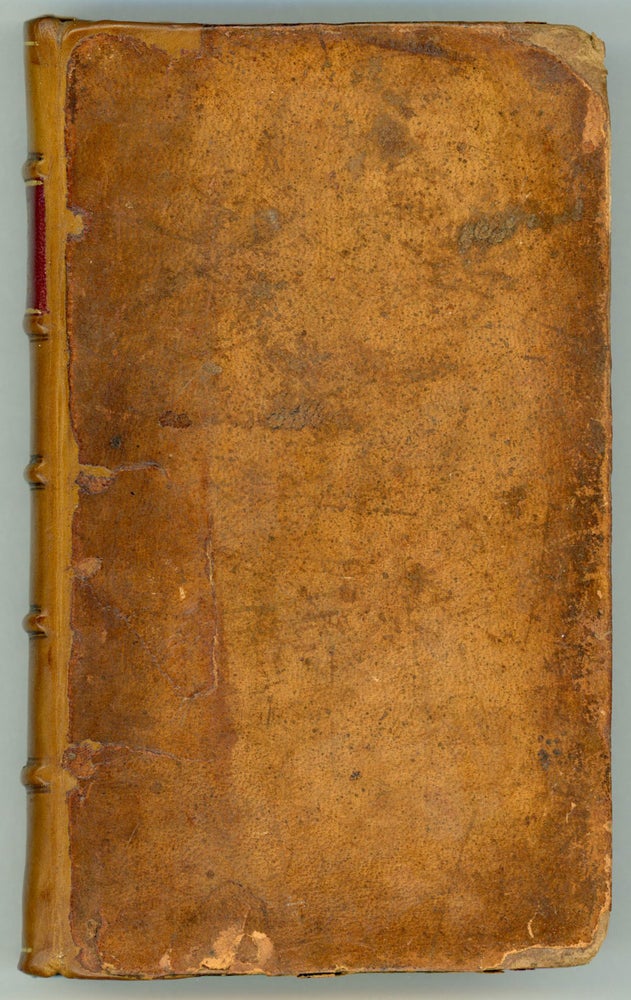VOYAGE DE NICOLAS KLIMIUS DANS LE MONDE SOUTERRAIN, CONTENANT UNE NOUVELLE TEORIE DE LA TERRE, ET L'HISTOIRE D'UNE CINQUIÊME MONARCHIE INCONNUE JUSQU' A' - PRESENT. OUVRAGE TIRÉ DE LA BIBLIOTHÉQUE DE MR. B. ABELIN; et Traduit du Latin par Mr. de Mauvillon. Copenhage: Chez Jaques Preuss, 1741. Small octavo, pp. [1-6] [1] 2-388, four inserted plates, one folded, title page printed in red and black, eighteenth century full calf, spine panel tooled in gold and blind, reddish brown title piece. First edition in French. Holberg's Niels Klim is the first important fictional use of astronomer Edmond Halley's theory (suggested in a paper to account for magnetic phenomena published by Royal Society in 1692) that the Earth (and the other planets) consisted of concentric, nested spheres surrounding a small central sun, with, possibly, openings at the poles. Holberg's satire was first published in Latin to gain a wide audience, which it did. The book was never banned in Denmark, though it was unpopular among religious powers of the time. "Holberg was one of the leading scholars and playwrights of the eighteenth century, perhaps the chief literary figure in Denmark to date. Niels Klim has been translated into at least thirteen languages and published in more than sixty editions, including at least eight in English. It is in the genre of the imaginary voyage which has been so much a part of utopian writing from its very beginnings. In this case the voyage to the interior of the earth comes about when Niels Klim falls down a shaft and finds himself in a new world. He visits a number of different countries including Potu the ideal state, which expels him for suggesting that women should not hold public office. Other states are modeled on various terrestrial countries; in Martinia (France) he is honored for inventing the periwig. In primitive Quama (Russia) he becomes emperor by leading the inhabitants to victory over neighboring nations, but rebellion against his tyranny forces him to flee. His journey ends when he crawls through another hole and finds himself back in Norway ... Scholars have pointed out numerous resemblances to Gulliver's Travels, and there are, indeed, many similarities. Perhaps the chief difference is that Swift was concerned with the behavior of individuals and Holberg with that of society." - Lewis, Utopian Literature, p. 92. "Essentially a satire on European culture and institutions in the guise of an imaginary voyage. It was translated into Danish not long after the Latin publication, and in Denmark its acceptance has paralleled that of Swift's Gulliver's Travels in the English-speaking world ... Holberg's work is an obvious imitation of Swift's Gulliver's Travels, and a comparison is called for. Holberg's satire is wider in scope, more penetrating in analysis, and less local than Swift's; the peculiarly British elements in Swift are not paralleled by Scandinavian elements in Holberg, who also lacks Swift's misanthropy. In imagination and literary polish, however, Swift is superior to Holberg." - Bleiler, Science-Fiction: The Early Years 1114. This is one of the three translations from the Latin original published in 1741, the others being German and Dutch translations; the work was not published in Danish or English until the following year. This French text was probably the most widely read of the eighteenth-century editions. Aldiss and Wingrove, Trillion Year Spree, pp. 78-9. Anatomy of Wonder (1976) 1-21; (1981) 1-100; (1987) 1-50; 6-346; and 6-390; (1995) 1-50; and (2004) II-536. Clute and Nicholls (eds), The Encyclopedia of Science Fiction (1993), p. 577. Costes and Altairac, Les Terres Creuses 20. Fortunati and Trousson (eds), Dictionary of Literary Utopias, pp. 459-60. Gibson and Patrick, "Utopias and Dystopias, 1500-1750" in Gibson, St. Thomas More: A Preliminary Bibliography (1961) 710. Gove, The Imaginary Voyage in Prose Fiction, pp. 303-5. Howgego, Encyclopedia of Exploration: Invented and Apocryphal Narratives of Travel H26. Locke, A Spectrum of Fantasy Volume III, pp. 44-5. Negley, Utopian Literature: A Bibliography 575. Nicolson, Voyages to the Moon, pp. 226-30. Leather worn at edges, professionally rebacked to style, engraved frontispiece quite tanned on blind side and there is mild loss along the fore-edge, not affecting the image, new endpapers, a few text leaves tanned, text clean, inserted leaf with biographical note on Holberg in English, in the hand of an early owner preserved at rear. An important, scarce edition of this seminal work. (#156352).
Price: $1,000.00
No statement of printing.


